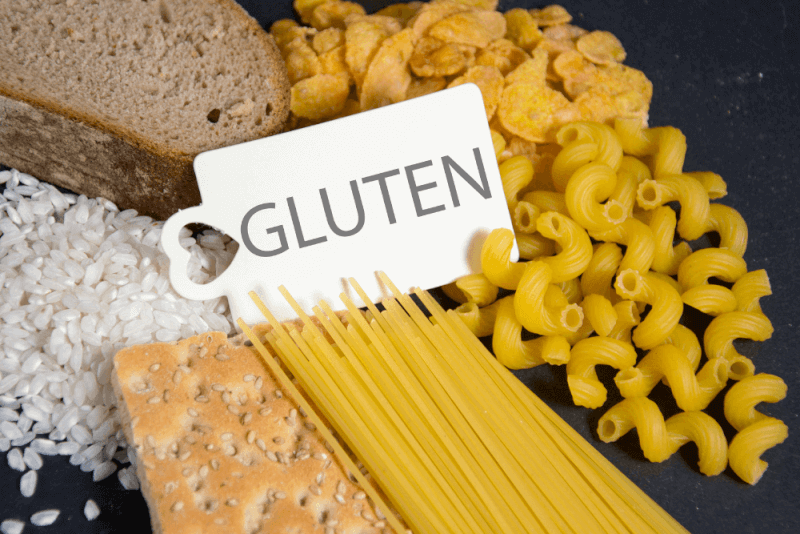What is Gluten?
Gluten is a type of protein found primarily in wheat and some grains, present in a wide range of products from processed foods like bread and pasta to cosmetics. Gluten is an umbrella term because it is a mixture of hundreds of different proteins. However, it primarily consists of two classes of proteins: gliadin, which gives the dough its rising ability during baking, and glutenin, responsible for the dough's elasticity.
Gluten is found in the endosperm structure of seeds. Its role is to ensure the swelling of the embryo during germination. When the seed is ground into flour, gluten acts as a binder that holds the food together. Therefore, it can be extracted to add flavor and texture to various foods.
Some enzymes in the human digestive system break down food, but these enzymes cannot completely break down gluten. Undigested gluten moves to the small intestine. If the small intestine functions healthily, undigested gluten is expelled from the body.
However, if an autoimmune reaction develops in the small intestine, various health problems can occur. Additionally, poorly digested carbohydrates, similar to the adverse effects caused by gluten, are called FODMAPs. Individuals with sensitive intestines may experience discomfort from fermentation in the intestines when consuming these carbohydrates.
Where is Gluten Found?
Gluten can be found as a standard ingredient in foods where wheat, barley, and rye are possible content ingredients, as well as in these grains and other products. Additionally, gluten is added as a binder, thickener, flavor enhancer, or colorant in some products. Therefore, it is essential to check the labels of processed foods for gluten content.
Unless labeled as gluten-free or made from corn, soy, or other gluten-free grains, the following foods typically contain gluten:
- Beer
- Breads
- Candies
- Bulgur
- Cereals
- Sauces
- Wafers
- Toast
- Cookies
- Crackers
- Seafood
- Processed meat products
- Pastas
- Malt products
- Unleavened bread
- Processed ready meals
- Soy sauce
- Chips
- Spicy rice mixtures
- Salad dressings
- Instant soups
- Broth
- Various soups
- Vegetables in sauces
- Processed chicken products
- Some prescription or over-the-counter medications
- Some cosmetic products
What is Gluten Allergy?
Also known as non-celiac gluten sensitivity, gluten allergy is often seen in people with irritable bowel syndrome. Additionally, individuals who are not celiac patients may also have difficulty digesting gluten.
Causes of Gluten Allergy
Gluten allergy occurs because the immune system perceives gluten as a foreign substance when individuals consume gluten. However, sensitivity can develop to any protein present in gluten in cases of gluten allergy.
Symptoms of Gluten Allergy
Due to the difficulty in digesting gluten, individuals with gluten allergy may experience certain digestive symptoms after consuming gluten. These symptoms include:
- Balance issues
- Gas
- Fatigue
- Abdominal pain
- Diarrhea
Some individuals may experience inflammation due to gluten allergy. However, these individuals do not show the intestinal damage seen in celiac disease.
Diagnosis Criteria for Gluten Allergy
To diagnose gluten allergy, the symptoms in the patient must first be identified. Then, tests are conducted to rule out the possibility of celiac disease. If symptoms are present but celiac disease is not observed, a diagnosis of gluten allergy can be made. However, there is no specific test to diagnose gluten allergy. Tests conducted to investigate celiac disease include:
Serology Test
This test, which looks for antibodies in the blood, helps determine whether the body has an immune reaction to gluten.
Genetic Tests for Human Leukocyte Antigens
These tests, targeting the HLA-DQ2 and HLA-DQ8 genes, help rule out celiac disease.
If the tests above indicate celiac disease, the following tests are also required.
Endoscopy
A camera is inserted through the mouth to examine the condition of the small intestine. If necessary, a tissue sample may be taken to detect damage to the villi.
Capsule Endoscopy
This test, which captures photos of the entire small intestine, uses a wireless camera. The camera is placed inside a swallowable capsule that travels through the digestive system, taking thousands of photos and transmitting them to a recording device. It is used in cases where a complete examination of the small intestine is required.
Treatment Methods for Gluten Allergy
The only way to manage gluten allergy is to avoid foods containing gluten. Patients must refrain from consuming these foods throughout their lives. Additionally, not consuming foods containing gluten may lead to certain vitamin deficiencies. To prevent this, various vitamin supplements may be needed. Recommended vitamin and mineral supplements for individuals on a gluten-free diet include:
- Copper
- Zinc
- Folic acid
- Vitamin K
- Iron
- Vitamin D
- Vitamin B12
Gluten Allergy and Nutrition
Individuals with gluten allergy must avoid grains like wheat and barley that contain gluten. However, their diet is not restricted. They can consume various foods, including fruits, vegetables, meat, poultry, fish, legumes, and dairy products.
In a gluten-free diet, various gluten-free options are generally used as flour substitutes. These options include:
- Buckwheat
- Almond flour
- Coconut flour
- Corn
- Cornstarch
- Guar gum
- Millet
- Pea flour
- Potato
- Quinoa
- Rice
- Sorghum
- Soy flour
- Teff
When following a gluten-free diet, it is essential to choose foods labeled gluten-free. The label should be third-party verified to avoid cross-contamination risks.
Foods that should be used frequently and are naturally gluten-free include:
- Fruits such as apples, bananas, kiwi, oranges, peaches, pears, and watermelon
- Vegetables such as carrots, cucumbers, peppers, broccoli, sweet potatoes, cabbage, and spinach
- Legumes such as lentils, beans, chickpeas, and kidney beans
- Protein sources such as chicken, turkey, red meat, tofu, eggs, and fish
- Dairy products
- Nuts such as almonds, cashews, chia seeds, pumpkin seeds, and sunflower seeds
Gluten and Celiac Disease
The immune response developed against gluten is called celiac disease. In celiac patients, an immune response to gluten is observed in the small intestine when gluten is consumed. Over time, this response damages the small intestine. This condition, known as malabsorption, affects the absorption of nutrients.
Symptoms of Celiac Disease
Symptoms that may be seen in individuals with celiac disease include:
- Diarrhea
- Constipation
- Fatigue
- Nausea
- Vomiting
- Weight loss
- Abdominal pain
- Bloating
- Gas
In addition to these symptoms, more than half of the patients experience symptoms unrelated to the digestive system, including:
- Anemia
- Osteoporosis
- Dermatitis herpetiformis
- Mouth ulcers
- Headaches
- Fatigue
- Numbness in hands and feet
- Nervous system damage
- Balance issues
- Cognitive impairment
- Joint pain
- Decreased spleen function
- High liver enzymes
In infants and children with celiac disease, the symptoms that may be observed include:
- Nausea
- Vomiting
- Pale and foul-smelling stool
- Chronic diarrhea
- Gas
- Abdominal swelling
- Constipation
If nutrients are not absorbed due to celiac disease, the symptoms that may be observed in infants and children include:
- Growth retardation
- Short stature
- Damage to tooth enamel
- Irritability
- Weight loss
- Anemia
- Delayed puberty
- Attention deficit
- Hyperactivity disorder
- Learning difficulties
- Headaches
- Lack of muscle coordination
- Seizures
Dermatitis Herpetiformis
Gluten intolerance causes dermatitis herpetiformis. Dermatitis herpetiformis is a blistering skin disease that usually causes rashes on the elbows, hairline, torso, knees, and buttocks. This disease, caused by changes in the small intestine similar to celiac disease, may not cause severe digestive problems.
Skin rashes are intermittent and extremely itchy. This disease also affects 10-15% of individuals with celiac disease.
Wheat Allergy
Unlike celiac disease or gluten intolerance, wheat allergy involves the immune system reacting to other proteins found in wheat. Therefore, individuals with wheat allergy do not encounter any problems when consuming other gluten-containing foods. Symptoms that may be observed in wheat allergy include:
- Cold-like symptoms
- Vomiting
- Diarrhea
- Swelling in the mouth and throat
- Itching in the mouth and throat
- Hives
- Skin rash
Gluten Ataxia
Gluten ataxia is a rare disease where the immune system attacks the nervous system upon consuming gluten. It can be related to celiac disease and gluten sensitivity or occur independently. Individuals with gluten ataxia typically do not show digestive system symptoms.
Gluten ataxia can affect brain coordination, causing individuals to feel clumsy or have difficulty maintaining balance. Symptoms that may occur in gluten ataxia include:
- Difficulty using hands, feet, fingers, arms, and legs
- Tingling in extremities
- Difficulty speaking
- Difficulty moving eyes
Complications of a Gluten-Free Diet
A gluten-free diet is extremely popular among individuals without gluten sensitivity or celiac disease for the following reasons:
- Helping with weight loss
- Improving overall health
- Enhancing stomach and intestinal health
- Increasing athletic performance
However, there are not enough studies to determine whether a gluten-free diet can achieve the goals mentioned above. If a healthy individual adopts a gluten-free diet, potential complications may include:
- Increased likelihood of weight gain.
- A diet poorer in iron, calcium, and fiber.
- Higher consumption of fats and sugars.
- Higher costs of gluten-free foods.
Health Benefits of Gluten
In individuals without any health issues that necessitate restricting gluten, the benefits of gluten include:
- Consuming 2-3 servings of whole grains daily reduces the risk of heart disease and stroke.
- It may help feed good bacteria in the intestines.








